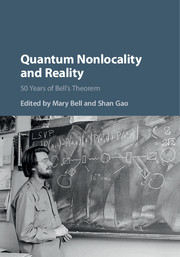Book contents
- Frontmatter
- Contents
- Contributors
- Preface
- Preface
- Part I John Stewart Bell: The Physicist
- Part II Bell's Theorem
- Part III Nonlocality: Illusion or Reality?
- 9 Strengthening Bell's Theorem: Removing the Hidden-Variable Assumption
- 10 Is Any Theory Compatible with the Quantum Predictions Necessarily Nonlocal?
- 11 Local Causality, Probability and Explanation
- 12 The Bell Inequality and the Many-Worlds Interpretation
- 13 Quantum Solipsism and Nonlocality
- 14 Lessons of Bell's Theorem: Nonlocality, Yes; Action at a Distance, Not Necessarily
- 15 Bell Nonlocality, Hardy's Paradox and Hyperplane Dependence
- 16 Some Thoughts on Quantum Nonlocality and Its Apparent Incompatibility with Relativity
- 17 A Reasonable Thing That Just Might Work
- 18 Weak Values and Quantum Nonlocality
- Part IV Nonlocal Realistic Theories
- Index
- References
17 - A Reasonable Thing That Just Might Work
from Part III - Nonlocality: Illusion or Reality?
Published online by Cambridge University Press: 05 September 2016
- Frontmatter
- Contents
- Contributors
- Preface
- Preface
- Part I John Stewart Bell: The Physicist
- Part II Bell's Theorem
- Part III Nonlocality: Illusion or Reality?
- 9 Strengthening Bell's Theorem: Removing the Hidden-Variable Assumption
- 10 Is Any Theory Compatible with the Quantum Predictions Necessarily Nonlocal?
- 11 Local Causality, Probability and Explanation
- 12 The Bell Inequality and the Many-Worlds Interpretation
- 13 Quantum Solipsism and Nonlocality
- 14 Lessons of Bell's Theorem: Nonlocality, Yes; Action at a Distance, Not Necessarily
- 15 Bell Nonlocality, Hardy's Paradox and Hyperplane Dependence
- 16 Some Thoughts on Quantum Nonlocality and Its Apparent Incompatibility with Relativity
- 17 A Reasonable Thing That Just Might Work
- 18 Weak Values and Quantum Nonlocality
- Part IV Nonlocal Realistic Theories
- Index
- References
Summary
Abstract
In 1964, John Bell proved that quantum mechanics is “unreasonable” (to use Einstein's term): there are nonlocal bipartite quantum correlations. But they are not the most nonlocal bipartite correlations consistent with relativistic causality (“no superluminal signalling”); maximally nonlocal “superquantum” (or “PR-box”) correlations are also consistent with relativistic causality. I show that – unlike quantum correlations – these correlations do not have a classical limit consistent with relativistic causality. The generalization of this result to all stronger-than-quantum nonlocal correlations is a derivation of Tsirelson's bound – a theorem of quantum mechanics – from the three axioms of relativistic causality, nonlocality, and the existence of a classical limit. But is it reasonable to derive (a part of) quantum mechanics from the unreasonable axiom of nonlocality?! I consider replacing the nonlocality axiom with an equivalent axiom that even Bell and Einstein might have considered reasonable: an axiom of local retrocausality.
In 1964, John Bell [1] proved that quantum mechanics is “unreasonable,” as defined by Einstein, Podolsky and Rosen [2] in 1935: “No reasonable definition of reality could be expected to permit this.” “This” (i.e., violation of “Einstein separability,” to use a technical term, or “spooky action at a distance,” as Einstein put it) turns out to be endemic to quantum mechanics. For example, pairs of photons measured at spacelike separations may yield nonlocal quantum correlations, i.e., correlations that cannot be traced to any data or “programs” the photons carry with them. As Bell [3] put it 20 years later, “For me, it is so reasonable to assume that the photons in those experiments carry with them programs, which have been correlated in advance, telling them how to behave. This is so rational that I think that when Einstein saw that, and the others refused to see it, he was the rational man. The other people, although history has justified them, were burying their heads in the sand. I feel that Einstein's intellectual superiority over Bohr, in this instance, was enormous; a vast gulf between the man who saw clearly what was needed, and the obscurantist. So for me, it is a pity that Einstein's idea doesn't work. The reasonable thing just doesn't work.”
- Type
- Chapter
- Information
- Quantum Nonlocality and Reality50 Years of Bell's Theorem, pp. 295 - 304Publisher: Cambridge University PressPrint publication year: 2016



